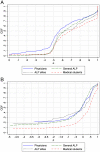Experimental evidence of physician social preferences
- PMID: 35867734
- PMCID: PMC9282368
- DOI: 10.1073/pnas.2112726119
Experimental evidence of physician social preferences
Abstract
Physicians' professional ethics require that they put patients' interests ahead of their own and that they should allocate limited medical resources efficiently. Understanding physicians' extent of adherence to these principles requires understanding the social preferences that lie behind them. These social preferences may be divided into two qualitatively different trade-offs: the trade-off between self and other (altruism) and the trade-off between reducing differences in payoffs (equality) and increasing total payoffs (efficiency). We experimentally measure social preferences among a nationwide sample of practicing physicians in the United States. Our design allows us to distinguish empirically between altruism and equality-efficiency orientation and to accurately measure both trade-offs at the level of the individual subject. We further compare the experimentally measured social preferences of physicians with those of a representative sample of Americans, an "elite" subsample of Americans, and a nationwide sample of medical students. We find that physicians' altruism stands out. Although most physicians place a greater weight on self than on other, the share of physicians who place a greater weight on other than on self is twice as large as for all other samples-32% as compared with 15 to 17%. Subjects in the general population are the closest to physicians in terms of altruism. The higher altruism among physicians compared with the other samples cannot be explained by income or age differences. By contrast, physicians' preferences regarding equality-efficiency orientation are not meaningfully different from those of the general sample and elite subsample and are less efficiency oriented than medical students.
Keywords: altruism; efficiency; equality; physicians; social preferences.
Conflict of interest statement
The authors declare no competing interest.
Figures
Similar articles
-
Social preferences of future physicians.Proc Natl Acad Sci U S A. 2017 Nov 28;114(48):E10291-E10300. doi: 10.1073/pnas.1705451114. Epub 2017 Nov 16. Proc Natl Acad Sci U S A. 2017. PMID: 29146826 Free PMC article.
-
Chinese physicians' attitudes toward and understanding of medical professionalism: results of a national survey.J Clin Ethics. 2014 Summer;25(2):135-47. J Clin Ethics. 2014. PMID: 24972064
-
Plastic surgery or primary care? Altruistic preferences and expected specialty choice of U.S. medical students.J Health Econ. 2018 Nov;62:45-59. doi: 10.1016/j.jhealeco.2018.09.005. Epub 2018 Sep 22. J Health Econ. 2018. PMID: 30273781
-
Patient preferences versus physicians' judgement: does it make a difference in healthcare decision making?Appl Health Econ Health Policy. 2013 Jun;11(3):163-80. doi: 10.1007/s40258-013-0023-3. Appl Health Econ Health Policy. 2013. PMID: 23529716 Review.
-
On the Road to Professionalism.Anesthesiology. 2017 May;126(5):780-786. doi: 10.1097/ALN.0000000000001545. Anesthesiology. 2017. PMID: 28187021 Review.
Cited by
-
The emergence of economic rationality of GPT.Proc Natl Acad Sci U S A. 2023 Dec 19;120(51):e2316205120. doi: 10.1073/pnas.2316205120. Epub 2023 Dec 12. Proc Natl Acad Sci U S A. 2023. PMID: 38085780 Free PMC article.
-
Physician Altruism and Spending, Hospital Admissions, and Emergency Department Visits.JAMA Health Forum. 2024 Oct 4;5(10):e243383. doi: 10.1001/jamahealthforum.2024.3383. JAMA Health Forum. 2024. PMID: 39392639 Free PMC article.
-
Looking inside the lab: a systematic literature review of economic experiments in health service provision.Eur J Health Econ. 2024 Sep;25(7):1177-1204. doi: 10.1007/s10198-023-01662-y. Epub 2024 Jan 11. Eur J Health Econ. 2024. PMID: 38212554 Free PMC article.
-
Understanding social media: how its popularity could be used to advance medical education in stroke care?J Neurol. 2023 Aug;270(8):4096-4102. doi: 10.1007/s00415-023-11743-w. Epub 2023 May 18. J Neurol. 2023. PMID: 37202604
-
Comparing Glycopyrronium/Formoterol Combination Therapy With Monotherapy in Moderate-to-Severe Chronic Obstructive Pulmonary Disease (COPD): A Narrative Review.Cureus. 2024 Apr 20;16(4):e58633. doi: 10.7759/cureus.58633. eCollection 2024 Apr. Cureus. 2024. PMID: 38770495 Free PMC article. Review.
References
-
- Arrow K. J., Uncertainty and the welfare economics of medical care. Am. Econ. Rev. 53, 941–973 (1963).
-
- Raz J., The Morality of Freedom (Clarendon Press, 1986).
-
- Marcia A., Kassirer P. K., Relman A., Looking back on the millennium in medicine. N. Engl. J. Med. 342, 42–49 (2000). - PubMed
-
- Dyrbye L. N., et al. , Relationship between burnout and professional conduct and attitudes among US medical students. JAMA 304, 1173–1180 (2010). - PubMed
-
- McGuire T. G., “Physician agency” in Handbook of Health Economics, Culyer A., Newhouse J., Eds. (Elsevier, 2000), vol. 1, pp. 461–536.
Publication types
MeSH terms
Grants and funding
LinkOut - more resources
Full Text Sources



